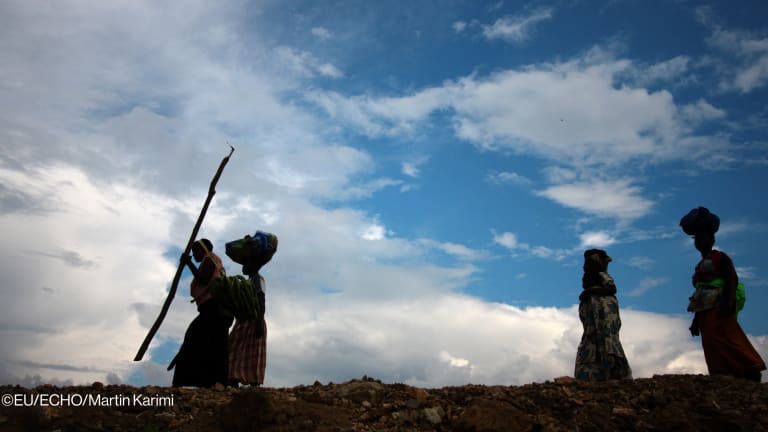
Women Deliver 2019 — the world’s largest conference on gender equality and health to power progress for girls and women — couldn’t come at a more critical time. As women’s rights are being eroded in the U.S. and around the world, it is the rising generation of girls who will feel the greatest burden.
More on women and gender equality:
► The future of women at work is alarming — and promising, new report shows
► To close gap in unpaid care work, a new call to action asks men to do more
Despite a surge in interest in championing adolescent girls, as a global community we are still failing to translate this into consistent benefits on the ground. Girls face untold obstacles and barriers. Persistent gender inequality, coupled with a dire lack of access to basic resources, limits their ability to truly thrive. Now more than ever, it is imperative that we invest in programs and policies that not only target the needs of girls but deliver real, lasting change.
Decades of research from my colleagues at the Population Council demonstrates what works, and doesn’t, to improve girls’ lives and should serve as a road map for future investments. Here are three things you need to know:
1. Reach girls early with proven interventions
Population Council research has shown that, while adolescence is a critical period for both girls and boys, girls experience it in a markedly different way. So if we really want to improve girls’ lives and set them up for success, we need to intervene early — with very young adolescent girls, between the critical ages of 10-14 years-old, before irreversible negative life events alter the trajectory of their lives.
A community mapping study my colleagues conducted in South Africa reveals the stark divergence in the lives of girls and boys during these critical years. At grade 5 (around the age of 10), girls had equal or greater geographic freedom than boys. But by grades 8 and 9 (around the age of 14, at the time of puberty), girls in urban settings saw their geographic freedom shrink by two-fifths.
Not only that, but boys’ geographic freedom had more than doubled, so that girls’ freedom was now only one-third of that of their male classmates. As they age through adolescence, boys’ worlds expand, bringing with it increased choice, freedom, and independence. Yet girls’ worlds literally shrink. Their access to the public sphere erodes, and so do their options and freedom.
Our research shows that from ages 15-19, too many adolescent girls experience a rapid confluence of negative events, including school dropout, marriage, violence, and early birth, that can see their lives go off track. Intervening early in those formative years between ages 10-14 has more potential to positively impact their lives and put them on a powerful path.
2. Take a girl-centered approach
Interventions that approach girls’ fully-lived realities are more likely to work. Research from the Population Council’s GIRL Center shows that approaches that target multiple levels of girls’ lives, including education, health, economic empowerment, social capital, and more, are the most likely to improve outcomes for girls and have lasting effects.
For example, the Population Council conducted a randomized control trial of the Adolescent Girls Initiative-Kenya, a girl empowerment program that reached more than 6,000 Kenyan girls ages 11-15. The project tested four layered packages, all with safe spaces as the base, and each added an additional component. The most effective package combined all four components — violence prevention, education, health, and wealth creation, showing the importance of layering multiple interventions to increase the overall positive impact on girls’ lives.
These findings from AGI-K resonated with our earlier studies, including a finding that much-celebrated cash transfers are more effective when combined with empowerment programs. Girls don’t live their lives in siloes, so why do programs often focus on a single intervention?
3. Tailor programs to the needs of specific girls
Adolescent girls are not a homogenous group. The needs of girls differ by age, whether they are in school, living with parents, and whether they are married or have children of their own. The increasing isolation experienced by adolescent girls means that if programs are not intentionally designed to reach and support girls, then they will often be excluded. And even when girls are included in programs, it is usually the most privileged among them who benefit, rather than those most in need.
The Population Council’s “Biruh Tesfa” — Bright Future — program in Ethiopia has demonstrated that if we get serious about considering girls’ specific needs, we can effectively reach the poorest and most vulnerable. Knowing that it wasn’t feasible for highly excluded and vulnerable child domestic workers to attend traditional programs, Biruh Tesfa reached girls through a combination of approaches including house-to-house recruitment, and provided girls’ groups led by female mentors, with education on HIV/AIDS, life skills, and basic literacy. Girls in the intervention were twice as likely as those in the control to report social support, score highly on HIV knowledge questions, and know where to get HIV counseling and testing.
Girls aren’t just the future — they are the present. They deserve support based on more than a hunch; they deserve programs based on evidence. Research is a powerful tool in our arsenal for change. It’s well past time that we used it.








